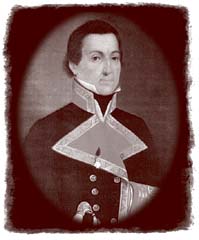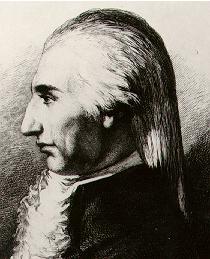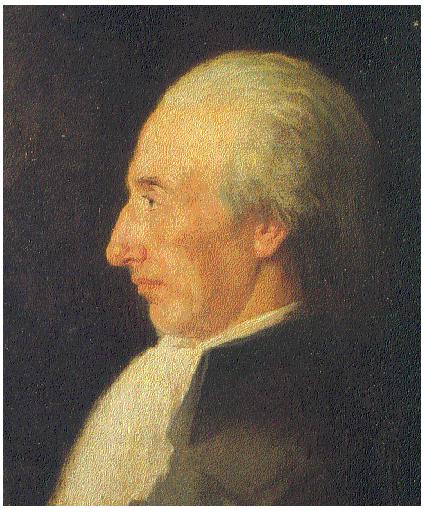A Biography of Alexandro Malaspina
by John Black and Dario Manfredi
Alexandro Malaspina was born on November 5, 1754 to the Marquis Carlo Morello
and Caterina Meli Lupi di Soragna. His birthplace, Mulazzo, in what is now
northern Tuscany, was then an imperial fiefdom, solely and directly dependent
on the Holy Roman Empire. From 1762 to 1765 he and his family lived in Palermo,
with his great-uncle Giovanni Fogliani Szorza d'Aragona, viceroy of Sicily.
From 1765 to 1773 he was a boarder, in Rome, at the Clementine College, run
by the Somaschi Fathers. Then, accepted into the Order of Malta, he lived
for about a year on that island and learned, in the Order's fleet, the rudiments
of the art of sailing. In 1774 he entered the Royal Navy of Spain and at Cádiz,
on November 18, received the rank of Guardiamarina.

In January 1775, aboard the frigate Santa Teresa, he participated in
the expedition in aid of Melilla, which was besieged by the Moroccans; a few
days later, he was promoted to frigate-ensign. In July of the same year he
participated in the siege in Algiers and in March of the following year he
was promoted to ship's ensign. From 1777 to 1779, aboard the frigate
Astrea, he made a voyage
to the Philippines (rounding the Cape of Good Hope on both the outward and
return journeys). During the voyage (in 1778) he was promoted to frigate-lieutenant.
In January 1780, aboard the vessel San Julian, he participated in the battle of Cape Santa Maria. In February he was promoted to ship's lieutenant. In 1782, while serving on the frigate Santa Clara, he was denounced to the Court of the Inquisition on suspicion of heresy. However, the affair had no immediate practical consequences. In September of the same year, he served aboard a floating battery in the attempt to take Gilbraltar. In December, aboard the vessel San Justo, he took part in fighting at Cape Espartel. A short time later he was promoted frigate-captain.
From March 1783 to July 1784, as second-in-command of the frigate Asunción, he undertook a second voyage to the Philippines (by way of the Cape of Good Hope). In 1785, on the brigantine Vivo, he turned his attention to hydrographic surveys, working on the cartography of some stretches of the Spanish coast. He was named Lieutenant of the Company of the Guardiamarinas of Cádiz. From September 1786 to May 1788, in command of the frigate Astrea, he made, on behalf of the Royal Philippine Company, a commercial voyage around the world (by way of the Cape of Good Hope on the outward leg and of Cape Horn on the return).
In September 1788, together with his colleague José
de Bustamante y Guerra, he proposed to the government of Spain the organization
of a political-scientific expedition, using two corvettes, to visit almost
all the Spanish possessions in America and Asia. A short time later he was
named Associate Correspondent of the Royal Academy of Sciences in Turin. The
expedition, consisting of the corvettes Descubierta
and Atrevida, sailed
from Cádiz on July 30, 1789. The ships had been designed and built
specially for the expedition, and named by Malaspina in honour of James
Cook's Discovery and Resolution (although the second name
is not the happiest of translations!).

In 1791 the King of Spain ordered Malaspina to search for a Northwest Passage
and, after examining the Alaska coast as far west as Prince William Sound,
he spent about a month at the Spanish outpost in Nootka Sound, on the west
coast of Vancouver Island, before returning to Mexico. During 1792 he dispatched
the schooners Sutíl and Mexicana, under the command of
Dionisio Alcalá Galiano and Cayetano
Valdés, to explore the Straits of Juan de Fuca and of Georgia.
It is as a result of this part of the expedition that Malaspina's name is
associated with the Nanaimo area, though he himself came no closer than Yuquot
on Nootka Island.1
After examining the political situation of the Spanish colonies in the Pacific, Malaspina concluded that instead of plundering them economically, Spain should develop a confederation of states whose members would conduct international trade. He suggested that Spain should abandon the military domination of far-off lands and establish a Pacific Rim trading bloc, managed by the Spaniards from Acapulco.
On September 21, 1794 the expedition returned to Cádiz after 62 months at sea. On December 7 Malaspina was received at El Escorial by King Charles IV and Prime Minister Manuel Godoy. In March he was promoted to fleet-brigadier. In September 1795 he tried to influence government politics with proposals and memoranda that did not reflect favourably on Godoy. On November 22, on the initiative of Godoy, the Council of State, presided over by Charles IV, ordered the arrest of Malaspina on a charge of plotting against the state. The officer was arrested twenty-four hours later.
On April 20, 1796, after an inconclusive trial, Charles IV decreed on his
own initiative that Malaspina be demoted and imprisoned in La Coruña
(in Galicia), in the isolated fortress of San Antón. From 1796 to 1802,
sequestered in the castle, Alexander Malaspina wrote a variety of essays in
economics, aesthetics and literary criticism.

Towards the end of 1802, as a result of pressure by Francesco
Melzi d'Eril and by Napoleon, Malaspina was freed from gaol, but had to
leave Spain immediately. In March 1803 he disembarked in Genoa and continued
on to Mulazzo, after reaching which he settled in nearby Pontremoli and began
to concern himself with local political problems, from a point of view which,
even today, appears surprisingly modern.
In December, an epidemic of yellow fever having appeared in Livorno, he was entrusted with organizing and directing a cordon sanitaire between the Italian Republic and the Kingdom of Etruria. In 1805 he was named Advising Auditor of the Council of State of the Kingdom of Italy.
In December 1806, in Florence, he was received at Court by the Queen of Etruria; a short time later he was admitted, with the title of Addomesticato, to the Columban Society in Florence. In 1807 there appeared the first symptoms of an incurable illness; he died, in Pontremoli, on April 9, 1810, at ten o'clock at night.
1 Some of the material in this paragaph and the next is extracted from an article in The Daily Colonist, Nov. 22, 1970.